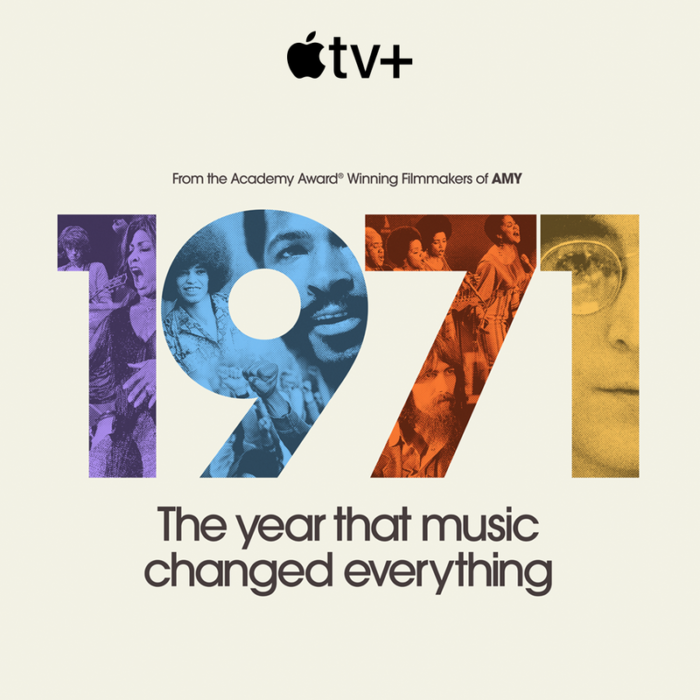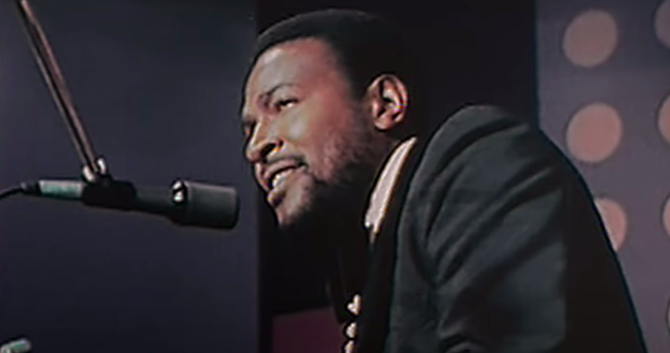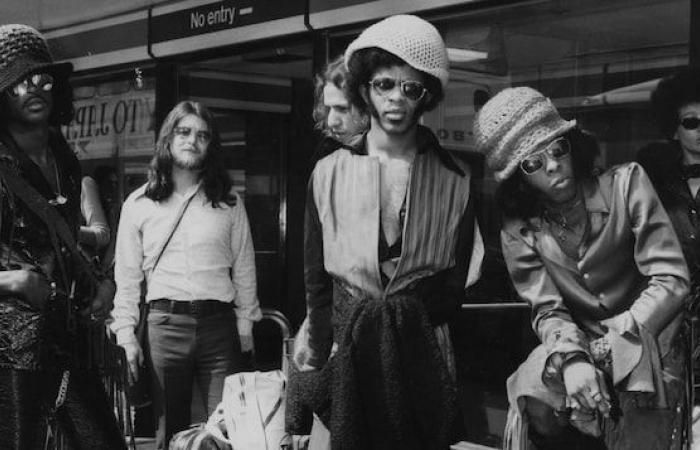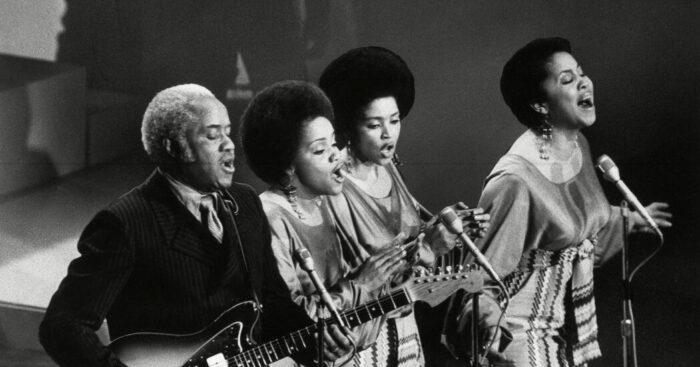By Vicky Bennett / GMS Coordinator

This month we had the absolute pleasure to speak with Music Supervisor, Iain Cooke, who takes us through the process of the new and perhaps most ambitious Documentary in terms of Music Supervision, 1971: The Year That Music Changed Everything.
How did you come to be involved with ‘1971: The Year That Music Changed Everything’ and what was it that drew you towards working on it?
— Is there a certain way you prepare before working on such a music-led documentary?
Iain Cooke:
I was first made aware of the project six years ago in the summer of 2015 while I was over in Cannes for the AMY premiere. That film was made by the same team that made this documentary series. The producer James Gay-Rees told me about a book that he’d optioned a manuscript for which was 1971: Never a Dull Moment by David Hepworth, and the broad premise is that in Hepworth’s opinion, 1971 is the greatest year in music ever.
It was a truly seminal year and for many reasons all these absolute classic and pivotal albums were being released. Everything from Marvin Gaye “What’s Going On” to Sly and the Family Stone “There’s A Riot Goin’ On”, Joni Mitchell “Blue”, Carole King “Tapestry”, Bowie “Hunky Dory”, an endless list of classics. Jame and I had some really early conversations whether a music documentary of this magnitude was even feasible and whether we’d even be likely to be able to secure the rights to all of these huge songs and copyrights.
I read the manuscript for the book at that time, and then many conversations over the years, then maybe three years later the production team started to broadly flesh out the project and tried to work out what format it would be, for example if it would be tackled chronologically like the book, and whether it would be released as several films through this year. Eventually it settled into an episodic format of 8 x 45 minutes each.
I’d say all Music Supervisors are researchers and crate-diggers and 1971 itself is a sweet spot in my record collection and many of these albums were already inherent favourites of mine and I have been very aware of the songs on the albums and lots of the backstories but as part of the process, I read the book, read around the era, I started to compile lists and familiarise myself with the music of the era, not just the main singles but the deeper cuts and lesser known album tracks too.
A project like this is a music lovers dream because the whole project is fascinating whilst having the opportunity work with such a great team. Asif Kapadia is one of the greatest filmmakers in the world at what he does, James Gay-Rees has such an amazing, proven track record of making these brilliant documentaries, and there was an amazing team including editor Chris King who cut Senna and Amy and Maradona. I knew the calibre of the project was promising because they’d put a incredibly strong team together.
The music is so fundamental to this story and the music team are crucial as a project like this can’t be made without the music knowledge and music rights, along with the brilliant archive team and incredible editorial team who pieced it together.
After you first read the script and music cues, what did you look forward to working on the most?
Iain:
A huge part of our job is to help the storytellers realise their vision. A documentary such as this is very different from a TV drama or film. We were working with songs that were either recorded or released or performed live during the year 1971, and the music supervision role becomes a huge rights negotiation. You’re liaising with the editorial team and helping with ideas but if they select a particular live performance or if there’s a certain piece of archive that’s fundamental to tell in the story then that question is put to the music team to feed back very quickly whether this is going to be a viable option and potentially clearable, rather than wasting days and days cutting a sequence that isn’t going to be able to be used.

It can be argued that this has been the most ambitious music documentary ever to be made in terms of the impressive music supervision work involved for going through the volume and level of artists and songwriters.
— Can you tell us a little about your process during this project and how you worked/collaborated with the directors to ensure each song chosen was successfully placed in the documentary?
Iain:
You’re right, perhaps the thing that sets this documentary aside is the level of the artists involved and I think we had over 150 songs in the series, 58 different artists, 108 different songwriters, and when you take into account that that includes the likes of The Rolling Stones, Marvin Gaye, John Lennon, Carole King, Joni Mitchell, Elton John, Aretha Franklin, Bob Dylan, Stevie Wonder, George Harrison, Bob Marley, James Brown, Curtis Mayfield, Miles Davis, Bill Withers, Pink Floyd and the list goes on and on, then is just amazing. One of the things we did try to do early on is have a call with the key rights holders at the record labels and publishers and introduce the project to them. They were incredibly supportive throughout the project. We let them know about our ambitions for the project, the shear scope of it and that we were hoping to tell the definitive story of 1971 and include the music that was released that year. You just hope that the bands and artists and songwriters and estates will hopefully want to be a part of that story.
It’s a different sort of process when you’re working on a film and you’re attaching a song of theirs to a scene, whereas essentially this series was rooted in 1971. There was a lot of support for it, we were always trying to have very open, transparent conversations with the rights holders and keep them informed.
We were incredibly lucky that early on in the editing process that we did receive blessing from both The Rolling Stones as well John Lennon’s estate which helps cement the documentary’s credentials. Even so, it was a long and intense process but there was a huge desire from all to be involved and support this project, and hopefully the end result is very rewarding for all to see.
How did you ensure you found the most original and raw pieces of music to illustrate the authenticity for the viewers watching?
Iain:
Again, massive credits to the archive and editorial team, they were scouring so many archives and digging up lots of previously unseen footage. There’s a lot of live performances which was deliberate, I think there’s something very personal when you see, for example, Carole King or Joni Mitchell perform live and there’s a device really, which in 1971 a lot of the way these artists would have been seen in people’s homes were through that power of the live performance and early TV recordings too. The filmmakers wanted to almost present those songwriters in a way they would’ve been seen by the people at the time. It’s pretty mad that it is fifty years ago this year.
Were there any personal music discoveries you made whilst travelling back into this era of music?
Iain:
Definitely, you could probably make another whole series with the music we weren’t able to include but again the filmmakers felt it was more important to do a deep dive into certain artists and discover their story rather than to try and cover all bases and dilute some of these stories. They really wanted to hone in on certain episodes whether it be Sly and Family Stone, or The Rolling Stones, Marvin Gaye or John Lennon etc.
I do think one of the artists that really shines through, and I was proud by how much time his music gets, was Gil Scott-Heron who’s an absolute favourite of mine. I think he’s perhaps an artist where, a lot of the viewing audience will be very aware of Marvin Gaye’s “Whats Going On” or John Lennon’s “Imagine” and I hope that this helps Gil Scott-Heron reach a new younger audience. His music was so political and it did sell a lot of albums at the time but when you hear songs such as “No-Knock” talking about where police didn’t need a reason, just to suspect and it’s scary. With the Attica Prison riots episode, Gil Scott-Heron, Marvin Gaye, Stevie Wonder, Curtis Mayfield, who were all part of the civil rights movement that was moving into the black power movement. You have Aretha Franklin standing side-by-side with Angela Davis offering to pay her bail bond, I just think it was an incredibly political time.
You only have to observe the events of the last year in the US and UK to know that a lot of these historic political and social issues are still here and very prevalent today. I think that’s one of the biggest takeaways from watching the series— you’re watching these events from fifty years ago and in many ways everything’s changed but deep down nothing’s really changed.

Do you think that making sure placing such important pieces of music in there helps to tell the story better for those political events?
Iain:
Definitely. Rockstars were the most influential people around and they weren’t scared to use their voice and support causes. Marvin Gaye wrote “What’s Going On” because he was upset about his brother being drafted to Vietnam. Jimmy Iovine say’s in the documentary ‘these albums were like Trojan horses, they came as beautiful music but really were delivering an incredibly political message’. You’ve got Marvin Gaye’s lyrics ‘There’s too many of you dying, war is not the answer, only love can conquer hate.’; on “Inner City Blues’: ’Rockets, moon shots, Spend it on the have nots…This ain’t livin’…Trigger-happy policing, Panic is spreading, God knows where we’re heading.’
John Lennon says that music reflects the state that society is in, on “Imagine” he’s writing songs like ‘All I Want is the Truth’ ‘I Don’t Want to be a Soldier Mama, I Don’t Wanna Die’. I think there’s just an incredibly political message throughout these albums.
The series starts with Kent State Massacre, which is pre-71’, Neil Young picks up a guitar and writes ‘Ohio’, Bob Dylan writes ‘George Jackson’ in tribute to the Black Panther leader George Jackson, who had been shot and killed by guards at San Quentin Prison.
It just feels like the songwriters and artists at the time were trying to support these causes and weren’t afraid to. That’s one of the most important things they can do is to use their voice and profile to highlight these issues and make sure we’re talking about them and also trying to do something to resolve them.
I suppose nowadays people may listen to these songs and not really understand he certain implications that came at the time so with this documentary it highlights what was actually happening in 1971 they weren’t just creating music to create music they were creating music to send a message.
Iain:
Absolutely. I think in the early 1970’s a lot of the topics were about marginalised people realising that nothing is impossible and having their time and there’s a revolutionary consciousness in music and society because of that.

What was your favourite scene to watch back when final mixing took place & what was your most memorable moment/highlight of working on this documentary?
Iain:
I’d say the two most memorable cues are, firstly Leonard Cohen’s “Avalanche” which plays over the sequence of the Attica Prison Riots which I think it one of the most powerful episodes and then also there’s a use of Stevie Wonder’s ‘Evil’ for some really quite harrowing scenes and when you watch the music and visuals together you can’t help but be affected. It’s difficult to pinpoint an individual highlight moment because I think the highlight is to get towards the end of this project and actually realise the ambitionse. It was over two years in the edit, and I think just to be able to actually help the filmmakers realise their vision for this unparalleled music documentary series is the highlight.
After tackling such an ambitious project, what advice would you give someone looking to become a supervisor?
Iain:
All of us involved at the Guild of Music Supervisors are big advocates of helping the next generation of music supervisors develop and I would always thoroughly recommend it as a career path if you have the passion and it’s something you want to pursue.
The 1971 project really highlights how diligent and how organised you have to be as as a music supervisor as well as forging long-lasting and trusting relationships with the Rights Holders and wider network that are based on honesty and transparency.
There are so many huge songs included and as a music supervisor you are trying to respect the copyrights and pay as much as is reasonably possible, but also taking into account the overall budget and the fact that we were trying to use over 150 of the biggest songs ever written within an eight-part series and managing that element.
It was huge fun to work on and there was huge pressure throughout but you have to have the confidence that you can solve problems as they arise, or that you’re able to find creative solutions that don’t compromise the overall aesthetic of the film or the series.
There is absolutely no way I could have done this project without my amazing music coordinator Estera Dabrowska and having her support, help with prepping the requests, keeping tabs on the approvals and so much more, and also my fantastic licensing colleague Pru Miller who had a gigantic mountain of paperwork to wade through. They should absolutely share in the success and enjoy their immense contributions as a vital part of this extraordinary documentary series too.
Thank you Iain for taking the time to speak with us here at GMS, it is a pleasure to be able to spotlight this project and we wish you all the best on any future projects!
You can now stream 1971: The Year That Music Changed Everything on Apple TV+ now!
